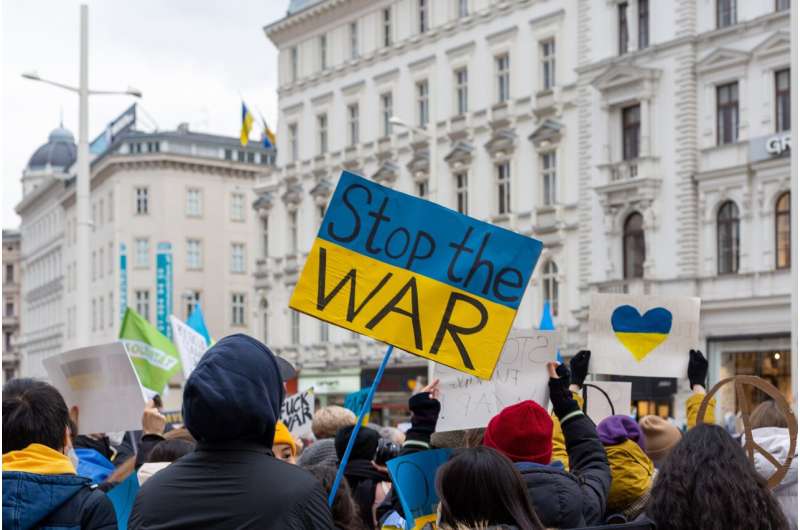Ukraine war: What are 'dirty bombs' and why is Russia suddenly talking about them?

Since the invasion of Ukraine in February, the threat that weapons of mass destruction would be used has been a constant concern. Discussion of this threat has tended to focus on the possibility that Russia might resort to using its nuclear arsenal—something hinted at several times by the Russian president Vladimir Putin and his senior colleagues.
On October 23 the Russian defense minister called his British, French and Turkish counterparts to claim that Ukraine was planning to use a "dirty bomb." The claim has widely been interpreted as a possible "false flag" operation by the Kremlin which might indicate that it is Russia that is planning to deploy such a weapon and blame it on Ukraine. But what are dirty bombs and have they ever been used?
The term refers to a device that uses conventional explosive mixed with radioactive materials designed to contaminate large areas. In a letter to the UN Security Council on October 24, Russia claimed that Ukraine is planning to use these devices at two sites inside its own territory. These are the Eastern Mineral Enrichment Plant in the central Dnipropetrovsk region and the Institute for Nuclear Research in Kyiv.
It is not the first time Russia has accused Ukraine of using weapons of mass destruction. In March 2022, Vasily Nebenzya, Russia's ambassador to the UN, told the Security Council that Russia had discovered evidence of US-funded biological weapons research in Ukraine.
Dirty bombs became part of the discourse on national security when it became clear that international terrorist networks such as al-Qaeda were trying to get hold of weapons of mass destruction but were unable to acquire pure fissile material or other components and technology to build a nuclear explosive device. In the event, such a weapon has never been used, despite various efforts by some terrorist groups. Two failed attempts to detonate such a device were reported in the southern Russian province of Chechnya more than 20 years ago. Investigators also found nuclear material capable of being used in a dirty bomb in an abandoned factory in Chechnya.
Unconventional weapons
A "dirty bomb" is a dispersion device containing radioactive material—possibly uranium, but more likely low-grade materials such as caesium-137 or other radioactive materials in common use. These are sometimes found, for example, in medical facilities that are not as highly protected as other sites with radioactive material. In 2020, a study was published in the Journal of Instrumentation on the effects of the dispersion of such radioactive materials in a densely populated metropolitan. It found that:
"the event is likely to have a small biological effect on local populations and that the main concern is the explosion itself, which can cause serious injuries and property damage. The radioactive materials used in a dirty bomb would probably not create enough radiation exposure to cause immediate serious illness or future detectable increases in cancer rates."
The study found that more people would die from the localized effects of the explosion than radiation. This suggests that the idea of dirty bombs as weapons of mass destruction are exaggerated.
So it seems that such a bomb is not an effective military weapon. But like the attacks on Ukraine's energy infrastructure, use of such a weapon could cause a serious dislocation of the civilian population. Many people would have to leave their homes and businesses for an indeterminate period of time.
Ominous warning
The west sees Russia's accusations as a preemptive attempt to shift the blame on Ukraine in the event of any incidents which cause major radiation leaks that could be due to a dispersal device. This has raised the suspicion that Russia itself is planning some attacks on the two named facilities.
The Institute of Nuclear Physics in Kyiv was created in 1944 to consolidate atomic research in Ukraine. It houses various nuclear research facilities including a VVR-M research reactor that was started in 1960 and involves fissile materials. The Eastern Mineral Enrichment Plant is involved in nuclear fuel production.
If the Russian military was to target these facilities it would risk releasing radioactive materials into the general environment—although the effect might not be on the same scale as using a nuclear bomb. The director general of the International Atomic Energy Agency, Rafael Mariano Grossi, announced on October 24 said the IAEA conducts regular visits to these sites to ensure all nuclear safeguards were observed. Grossi added that at the request of the Ukrainian government, it will conduct a further visit in the near future to verify conditions at the two sites.
Shoigu's claims must be balanced against the doubt that the Ukrainian government or military would want to put its own people at such risk and Russia is unlikely to be able to garner much support for these allegations in the UN. But the major concern is that this is an indication that Russia—which has suffered multiple setbacks on the battlefield in recent months—could be planning some unconventional method of escalation and is trying to preemptively shift the blame for any death and destruction on to Ukraine.
Provided by The Conversation
This article is republished from The Conversation under a Creative Commons license. Read the original article.![]()





















